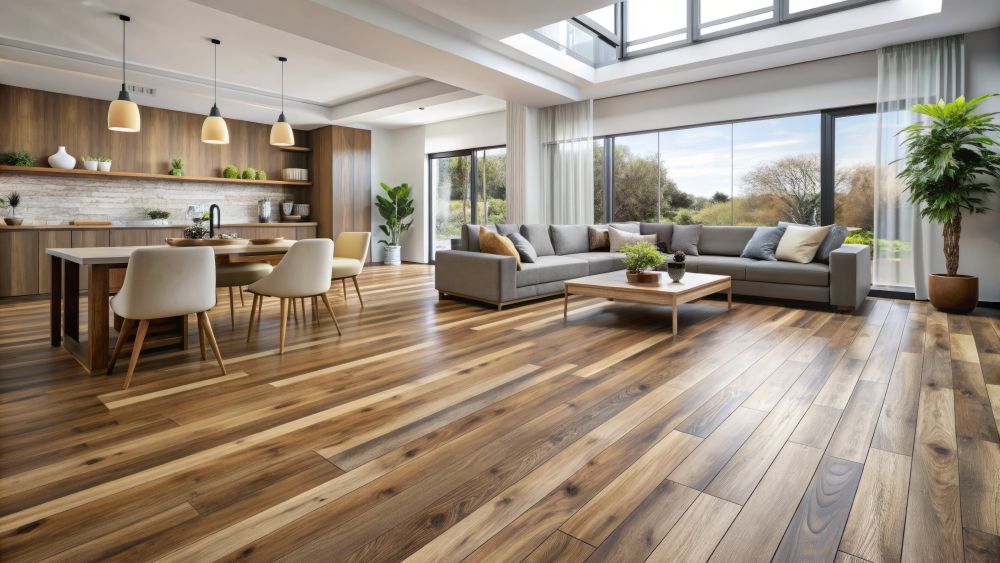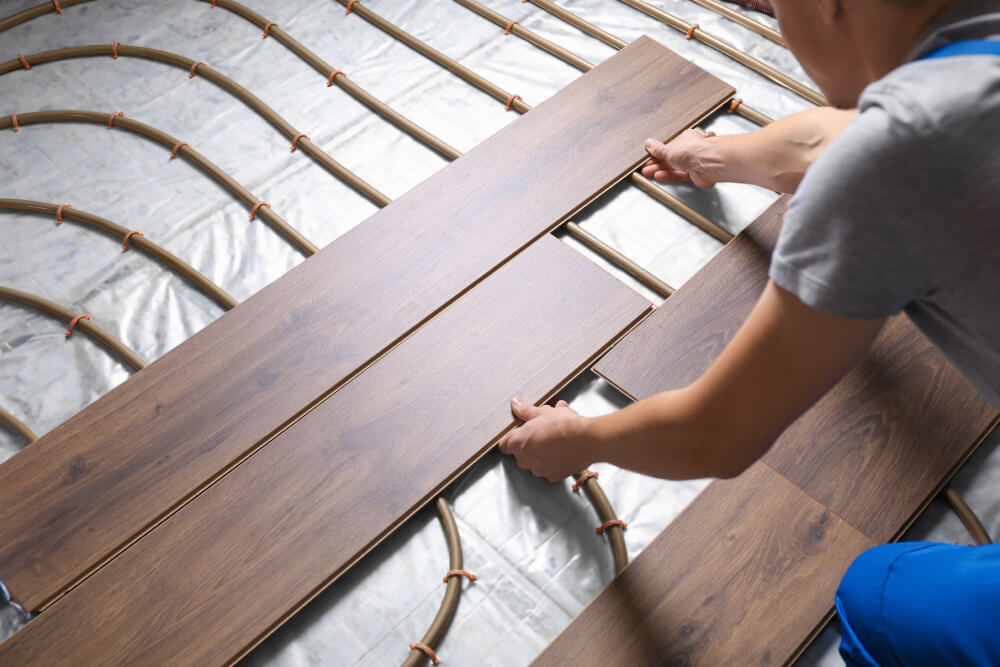Hardwood flooring is a classic and timeless choice that adds warmth, beauty, and value to any home. With a variety of types, styles, and finishes available, homeowners can find hardwood flooring that suits their aesthetic preferences and functional needs. This comprehensive guide will explore the different types of hardwood flooring, discuss the pros and cons, and provide tips for selecting, installing, and maintaining hardwood floors.
1. Understanding Hardwood Flooring
Overview: Hardwood flooring is made from solid wood or engineered wood products. It is prized for its durability, natural beauty, and ability to enhance the value of a home. Hardwood floors come in various species, finishes, and styles, offering a wide range of options to suit different tastes and applications.Types of Hardwood Flooring:
1. Solid Hardwood:- Description: Made from a single piece of wood, solid hardwood flooring is typically 3/4 inch thick. It can be sanded and refinished multiple times over its lifespan.
- Common Species: Oak, maple, cherry, walnut, hickory, and ash.
- Installation: Nailed or stapled to a wooden subfloor. Not recommended for basements or areas with high humidity.
- Description: Composed of multiple layers of wood veneer, engineered hardwood has a top layer of real hardwood and a core made of plywood or high-density fiberboard. This construction makes it more stable and resistant to moisture and temperature changes.
- Common Species: Same as solid hardwood, with additional exotic options like bamboo and eucalyptus.
- Installation: Can be glued, nailed, or floated over various subfloors, including concrete. Suitable for basements and areas with fluctuating humidity.
- Description: Sourced from trees outside North America, exotic hardwoods offer unique colors, grain patterns, and hardness levels. They are often more expensive and may have different sustainability considerations.
- Common Species: Brazilian cherry, teak, mahogany, tigerwood, and acacia.
- Installation: Similar to solid and engineered hardwood, depending on the product’s construction.
- Description: Reclaimed hardwood is sourced from old buildings, barns, and other structures. It offers a rustic, weathered appearance and is an eco-friendly option.
- Common Species: Varies widely, including oak, pine, and chestnut.
- Installation: Typically nailed or glued, with special attention to leveling and subfloor preparation.
2. Pros of Hardwood Flooring
Overview: Hardwood flooring offers numerous benefits, making it a popular choice for many homeowners. Here are some of the key advantages: 1. Aesthetic Appeal:- Natural Beauty: Hardwood floors bring the warmth and elegance of natural wood into your home. Each plank has unique grain patterns, colors, and textures that add character to any room.
- Variety: With a wide range of wood species, finishes, and styles, homeowners can find hardwood flooring that complements their interior design.
- Strength: Hardwood is a durable flooring material that can withstand heavy foot traffic, making it suitable for high-use areas like living rooms and hallways.
- Longevity: Properly maintained hardwood floors can last for decades, and solid hardwood can be refinished multiple times to restore its original beauty.
- Investment: Hardwood flooring is considered a premium flooring option that can increase the value of your home. It is often a desirable feature for potential buyers.
- Timeless Style: Hardwood flooring has a timeless appeal that works well with various interior design styles, from traditional to modern.
- Refinishing Options: Solid hardwood can be sanded and refinished to change the color or restore its appearance, allowing for flexibility in design updates.
- Non-Allergenic: Hardwood floors do not trap dust, pollen, and other allergens like carpet, making them a healthier choice for individuals with allergies or respiratory issues.
- Easy to Clean: Hardwood floors are easy to clean and maintain, contributing to a cleaner indoor environment.
Join HICP Homeowner’s Alliance
Connect with experts, get special discounts and enjoy member benefits
3. Cons of Hardwood Flooring
Overview: While hardwood flooring offers many benefits, it also has some drawbacks that homeowners should consider. Here are some of the key disadvantages: 1. Cost:- Initial Investment: Hardwood flooring is more expensive than other flooring options like laminate, vinyl, or carpet. The cost of materials and installation can be significant.
- Refinishing Costs: While refinishing extends the life of hardwood floors, it can be costly and inconvenient.
- Water Damage: Hardwood floors are susceptible to water damage, which can cause warping, swelling, or staining. They are not recommended for bathrooms, laundry rooms, or other areas with high moisture levels.
- Humidity Fluctuations: Changes in humidity can cause hardwood to expand and contract, leading to gaps or cupping.
- Scratches and Dents: Hardwood floors can be scratched or dented by heavy furniture, pets, or high heels. Regular maintenance and protective measures are necessary to keep them looking their best.
- Refinishing Needs: Over time, hardwood floors may need to be refinished to remove scratches, stains, and wear marks.
- Subfloor Requirements: Solid hardwood requires a specific type of subfloor, typically plywood, for proper installation. This can add to the overall cost and complexity of the project.
- Professional Installation: While some homeowners may choose to install hardwood floors themselves, professional installation is often recommended for the best results, adding to the cost.
4. Selecting the Right Hardwood Flooring
Overview: Choosing the right hardwood flooring involves considering various factors, including wood species, finish, and installation method. Here are some tips to help you make an informed decision: 1. Wood Species:- Domestic Species: Oak, maple, cherry, and hickory are popular domestic hardwood species known for their durability and classic appearance.
- Exotic Species: Brazilian cherry, teak, and mahogany offer unique colors and patterns but may come with higher costs and sustainability concerns.
- Hardness: Consider the hardness of the wood species, which affects its durability. The Janka hardness scale measures the resistance of wood to denting and wear. For example, hickory and maple are harder than oak and cherry.
- Prefinished: Prefinished hardwood comes with a factory-applied finish, making installation faster and less messy. It also offers a more consistent finish and greater durability.
- Unfinished: Unfinished hardwood is sanded and finished on-site, allowing for customization of the stain and finish. It provides a seamless look but requires more time and effort during installation.
- Nail-Down: Solid hardwood is typically installed using the nail-down method, which involves nailing the planks to a wooden subfloor. This method provides a secure fit but requires a specific subfloor type.
- Glue-Down: Engineered hardwood can be glued down to the subfloor, making it suitable for concrete and other subfloors.
- Floating: Engineered hardwood can also be installed as a floating floor, where the planks are not attached to the subfloor but instead click together. This method is easier and faster to install.
- Width: Hardwood planks come in various widths, from narrow strips (2-3 inches) to wide planks (5-12 inches). Wider planks can make a room appear larger and more open but may be more susceptible to moisture-related issues.
- Length: Longer boards create a more seamless look with fewer joints, while shorter boards can add visual interest and are often more affordable.
- Natural Variation: Consider the natural color and grain variation of the wood species, which adds character and uniqueness to your floor.
- Staining Options: If choosing unfinished hardwood, you can customize the stain color to match your interior design preferences.
5. Installing Hardwood Flooring
Overview: Proper installation is crucial for the longevity and appearance of hardwood flooring. While some homeowners may choose to install hardwood floors themselves, professional installation is often recommended for the best results. Here are the general steps involved in installing hardwood flooring: Steps:- 1. Preparing the Subfloor:
- Clean and Level: Ensure the subfloor is clean, dry, and level. Remove any debris, nails, or staples.
- Moisture Barrier: Install a moisture barrier if needed, especially for installations over concrete or in areas with high humidity.
- 2. Acclimating the Wood:
- Acclimation Period: Allow the hardwood planks to acclimate to the room’s temperature and humidity for at least 48-72 hours before installation. This helps prevent expansion and contraction after installation.
- 3. Laying the Planks:
- Layout Plan: Plan the layout of the planks, starting from the longest and straightest wall. Stagger the end joints for a more natural look and added stability.
- Cutting Planks: Cut the planks as needed to fit around obstacles and along walls, leaving a small expansion gap around the perimeter.
- 4. Installation Methods:
- Nail-Down: For solid hardwood, nail the planks to the subfloor using a flooring nailer. Ensure the nails are driven into the tongue of each plank at a 45-degree angle.
- Glue-Down: For engineered hardwood, apply adhesive to the subfloor and press the planks into place. Use a notched trowel to spread the adhesive evenly.
- Floating: For floating floors, connect the planks using the tongue-and-groove or click-lock system. No adhesive or nails are needed, but an underlayment is typically required for sound insulation and moisture protection.
- 5. Finishing Touches:
- Trim and Molding: Install baseboards, shoe molding, or quarter-round to cover the expansion gap and provide a finished look.
- Cleaning: Clean the floor to remove any dust or debris from the installation process.
6. Maintaining Hardwood Flooring
Overview: Regular maintenance is essential to keep hardwood floors looking their best and prolong their lifespan. Here are some tips for maintaining hardwood flooring: 1. Cleaning:- Dust and Sweep: Regularly dust and sweep the floor to remove dirt and debris that can scratch the surface.
- Vacuum: Use a vacuum with a hardwood floor attachment to clean between the planks and in hard-to-reach areas.
- Damp Mop: Occasionally damp mop the floor with a hardwood floor cleaner, ensuring the mop is only slightly damp to avoid water damage.
- Furniture Pads: Use felt pads under furniture legs to prevent scratches and dents.
- Rugs and Mats: Place rugs or mats in high-traffic areas and entryways to reduce wear and dirt.
- Pet Nails: Keep pet nails trimmed to avoid scratches.
- Regular Inspection: Periodically inspect the floor for signs of wear, scratches, or dullness.
- Refinishing Process: Sand and refinish the floor as needed to restore its original beauty. Solid hardwood can be refinished multiple times, while engineered hardwood may have a limited number of refinishes depending on the thickness of the top veneer layer.
Hardwood flooring is a timeless and versatile choice that adds value and beauty to any home. By understanding the different types of hardwood flooring, weighing the pros and cons, and following best practices for selection, installation, and maintenance, homeowners can enjoy the benefits of hardwood floors for years to come. Whether you choose solid, engineered, exotic, or reclaimed hardwood, the investment in quality flooring will enhance the aesthetic appeal and functionality of your living space. With proper care and maintenance, hardwood floors can provide a durable and elegant foundation for your home.








